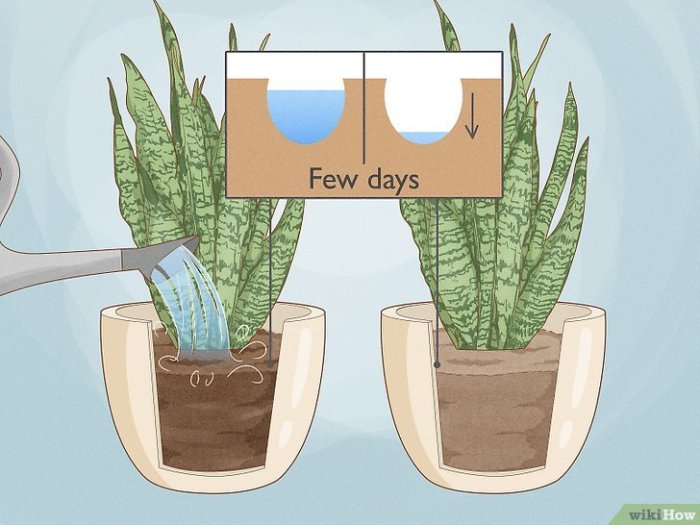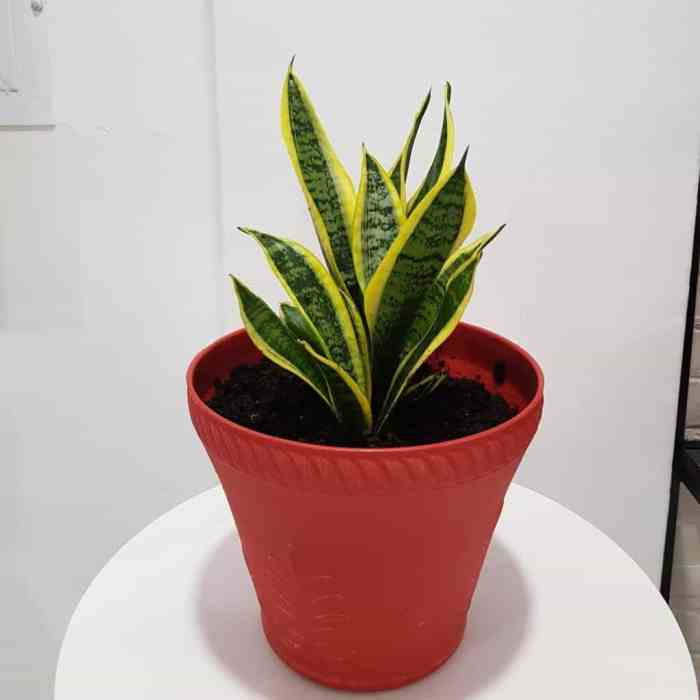How Much to Water Snake Plant After Repotting
Initial Watering After Repotting
How much to water snake plant after repotting – Proper watering after repotting a snake plant is crucial for its survival and healthy growth. Waiting before watering allows the roots to recover from the transplant shock and to establish themselves in the new soil. Overwatering, on the other hand, can lead to serious issues, including root rot and eventual plant death.
Importance of Delayed Watering
Repotting is stressful for snake plants. Their roots are disturbed, and the plant needs time to adjust to its new environment. Watering immediately after repotting can drown the stressed roots, preventing them from properly establishing themselves in the new soil. This delay allows the roots to heal and begin to explore their new surroundings.
Consequences of Overwatering
Overwatering a newly repotted snake plant can lead to several negative consequences. The most significant is root rot, a fungal disease that causes the roots to decay and eventually kill the plant. Other symptoms of overwatering include yellowing leaves, mushy stems, and a foul odor emanating from the soil. Prevention is far better than cure in this instance.
Timeline for First Watering
The ideal time to water a newly repotted snake plant depends on several factors, including the type of soil used and the size of the pot. Generally, it’s best to wait at least one to two weeks after repotting before watering. Smaller pots will dry out faster than larger ones, requiring more frequent watering once the initial waiting period is over.
For very well-draining soil mixes, the waiting period can be slightly shorter, while poorly draining mixes will necessitate a longer wait.
Watering Needs Based on Soil Mix
| Soil Type | Recommended Waiting Period (days) | Initial Watering Amount | Watering Frequency (after initial watering) |
|---|---|---|---|
| Cactus Mix | 7-10 | Thorough soaking until water drains from the bottom | Every 2-3 weeks |
| Well-draining Potting Mix | 10-14 | Thorough soaking until water drains from the bottom | Every 2-4 weeks |
| Standard Potting Mix | 14-21 | Moderate watering, allowing the top inch of soil to dry between waterings | Every 3-4 weeks |
| Heavy Clay Soil | 21+ | Water sparingly, only when the soil is completely dry | Every 4-6 weeks |
Assessing Soil Moisture
Accurately determining soil moisture is essential for preventing both underwatering and overwatering. Regular monitoring ensures the snake plant receives the appropriate amount of water, promoting healthy growth.
Methods for Determining Soil Moisture

Source: wikihow.com
There are several reliable methods to check soil moisture. Visual inspection can reveal if the top inch of soil is dry. A finger test involves inserting your finger about an inch into the soil. If it feels dry, it’s time to water. If it’s still moist, wait a few more days.
Using a moisture meter is another option, though less crucial than the first two.
Signs of Underwatering and Overwatering
Underwatering manifests as dry, brittle leaves that may droop or curl. Overwatering, conversely, leads to yellowing, mushy leaves, and a potential foul odor from the soil. Root rot, a severe consequence of overwatering, is indicated by soft, decaying roots.
Impact of Different Potting Mixes on Watering Frequency

Source: plantscraze.com
Different potting mixes retain moisture differently. Well-draining mixes like cactus mixes dry out faster than heavier mixes, requiring more frequent watering. Heavier mixes retain moisture for longer periods, necessitating less frequent watering. Choosing the right potting mix is key to establishing an appropriate watering schedule.
Visual Guide to Ideal Soil Moisture, How much to water snake plant after repotting
Completely Dry: The soil is light and crumbly, easily pulling away from the pot sides. Slightly Dry: The top inch or two of soil is dry, but the soil beneath is still slightly moist. This is the ideal condition for watering. Moist: The soil retains some moisture throughout, but it’s not soggy. Soggy: The soil is waterlogged, and water is pooling at the bottom of the pot.
This indicates overwatering.
Watering Techniques
Choosing the right watering method and technique ensures the snake plant receives adequate hydration without causing problems. Different methods have their own advantages and disadvantages.
Best Practices for Watering Snake Plants
Both top watering (pouring water directly onto the soil) and bottom watering (placing the pot in a tray of water) are effective methods. Top watering is simpler, but bottom watering allows the plant to absorb water at its own pace, reducing the risk of overwatering. Avoid getting water on the leaves, as this can lead to fungal diseases.
Advantages and Disadvantages of Watering Methods
Top Watering: Simple and quick, but can lead to uneven watering and potential for runoff. Bottom Watering: More even watering, reduces risk of overwatering, but takes longer and requires monitoring.
Creating a Self-Watering System
A self-watering system can be created using a reservoir at the bottom of the pot, connected to the soil through a wicking material. This method provides consistent moisture without the need for frequent watering. Careful consideration of pot size and material is necessary to prevent root rot.
Step-by-Step Guide to Watering
1. Check soil moisture. 2. If dry, water thoroughly until water drains from the bottom. 3.
Allow excess water to drain completely. 4. Avoid letting the pot sit in standing water. 5. Adjust watering frequency based on soil moisture and environmental conditions.
When repotting a snake plant, water sparingly initially, allowing the soil to dry out almost completely before the next watering. The frequency is similar to that needed for other drought-tolerant plants; for instance, you might find guidance on appropriate watering schedules by checking out this helpful resource on how much to water a money plant , as both plants share similar water requirements.
Remember, overwatering is a common mistake with snake plants, so err on the side of underwatering after repotting.
Environmental Factors
Environmental factors significantly influence how frequently a snake plant needs watering. Understanding these factors helps create a tailored watering schedule.
Influence of Temperature, Humidity, and Light
Higher temperatures and lower humidity lead to faster soil drying, requiring more frequent watering. Bright light also increases the rate of transpiration, increasing the plant’s water needs. Conversely, cooler temperatures, higher humidity, and lower light levels slow down soil drying.
Watering Needs in Different Environments
Indoor snake plants generally need less frequent watering than outdoor plants, especially in shaded areas. Sunny locations will dry out the soil faster. Humidity plays a significant role; drier climates necessitate more frequent watering.
Adjusting Watering Based on Environmental Conditions
A flowchart would visually represent the decision-making process: Start -> Check environmental conditions (temperature, humidity, light) -> Determine soil moisture -> Adjust watering frequency accordingly (more frequent in hot, dry, bright conditions; less frequent in cool, humid, shady conditions) -> End.
Long-Term Watering Schedule: How Much To Water Snake Plant After Repotting
Establishing a consistent watering routine is key to maintaining a healthy snake plant. This involves monitoring the plant’s health and adjusting the schedule as needed.
Establishing a Consistent Watering Schedule
Begin with a conservative watering schedule based on the soil type and environmental conditions. Monitor the soil moisture regularly, adjusting the frequency as needed. The goal is to allow the top inch or two of soil to dry out between waterings, while avoiding completely drying out the root ball.
Signs Indicating Watering Needs
Signs of underwatering include dry, brittle leaves that may droop or curl. Signs of overwatering include yellowing, mushy leaves, and a foul odor from the soil.
Sample Watering Schedule
Summer (warm, dry): Every 1-2 weeks. Spring/Autumn (moderate): Every 2-3 weeks. Winter (cool, dry): Every 3-4 weeks. These are guidelines only; adjust based on your specific environment and the soil type.
Preventing Watering Problems
To prevent root rot, ensure good drainage and avoid letting the pot sit in standing water. Leaf discoloration can be a sign of either overwatering or underwatering; carefully monitor soil moisture and adjust accordingly. Using well-draining soil and appropriate sized pots are preventative measures.
Answers to Common Questions
What type of water should I use to water my snake plant?
Use room-temperature water; avoid using cold water directly from the tap.
My snake plant leaves are drooping. Is it underwatered or overwatered?
Drooping leaves can indicate both under and overwatering. Check the soil moisture; dry soil suggests underwatering, while soggy soil points to overwatering.
How often should I check the soil moisture after repotting?
Check the soil moisture daily for the first week after repotting, then every few days, adjusting your frequency based on your observations.
Can I use a self-watering pot for my snake plant?
Yes, self-watering pots can be beneficial, but ensure the pot has excellent drainage to prevent waterlogging.




















